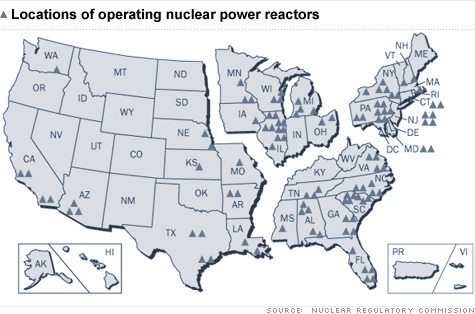 Stricter safety measures sought as Japanese officials try to avert a total meltdown.
Stricter safety measures sought as Japanese officials try to avert a total meltdown.
NEW YORK (CNNMoney) -- The safety of America's nuclear reactors is being questioned as Japanese engineers scramble to avert a total meltdown at two of that country's quake-stricken power plants.
Like in Japan, some of the 104 nuclear reactors in the United States are situated along the ocean -- some in earthquake-prone areas.
The reactors are designed to withstand earthquakes, sabotage and other disasters. But the difficulty the Japanese are facing in controlling their plants is raising red flags about the safety of U.S. facilities.
"The tragic events now unfolding in Japan could very easily occur in the United States," Rep. Ed Markey, a Massachusetts Democrat who sits on the House committee overseeing nuclear power, said in a statement.
Markey has recommended several measures that he believes should be taken by the Obama administration and the Nuclear Regulatory Commission.
These steps include stronger safety systems in plants located near fault lines, emergency response drills that model instances when more than one disaster unfolds simultaneously, and the distribution of radiation-blocking potassium iodide pills to everyone living within 20 miles of a reactor. (Such pills are now disbursed to people within 10 miles of a reactor.)
The United States has 104 non-military nuclear reactors operating at 65 plants across the country. In addition, there are dozens of reactors, weapons labs and other nuclear facilities associated with national defense.
Most of the civilian plants are located near major population centers. They currently supply about 20% of the nation's power.
There hasn't been a new nuclear plant commissioned since the Three Mile Island meltdown in Pennsylvania in 1979, although dozens that were under construction at the time have come on line.
More recently, increased electricity use, a desire to generate homegrown energy and concern over global warming have made carbon-free nuclear power more attractive.
The government has set aside $18 billion for new nuclear plants, and President Obama wants to spend an additional $36 billion.
Federal regulators are reviewing 20 applications to build new nuclear plants, and several existing facilities have applied to extend their operating licenses. Some were calling it a nuclear industry renaissance.
The events in Japan have obviously made the political climate for building more nuclear plants in the U.S. more difficult.
"The debate has been altered -- at least in the near term," Christine Tezak, an energy and environmental policy analyst at asset management firm Robert W. Baird & Co., wrote in a research note Monday.
Concerns over safety -- as well as cost -- continue to dog the nuclear industry.
In the United States, perhaps the most vulnerable plants are the two in California built on the Pacific coast near the San Andreas fault.
Those plants were built to withstand a magnitude 7.5 earthquake, said Robert Alvarez, a nuclear expert at the Institute for Policy studies and a former senior official at the U.S. Department of Energy.
The San Francisco quake of 1906 measured 8.3, said Alvarez, while Friday's Japanese quake was a massive 8.9. An 8.9 quake is 125 times as powerful as 7.5 quake, according to the United States Geological Survey.
"I don't think we should renew those operating licenses," he said.
Alvarez also said the problems at the Japanese facilities highlight the catastrophic outcome of the failure of power, pumps and other infrastructure. Such system malfunctions could happen because of an earthquake or a massive terrorist attack, such as one involving airliners.
Spokesmen for the utilities that own the California plants, Pacific Gas & Electric (PCG, Fortune 500) and Southern California Edison, said Sunday the plants are designed to meet the maximum quake projected for their immediate vicinity, which is not thought to exceed a magnitude of 6.5.
In addition, tests have shown that the country's nuclear plants could withstand an impact from an airliner, said Steve Kerekes, a spokesman for industry group the Nuclear Energy Institute.
Responding to Congressman Markey's recommendations, Kerekes said that safety systems at U.S. plants are already robust. He said that disaster planning could always be improved upon, but that studies show there's no need to distribute iodide pills beyond the current 10 mile radius.
A spokesman for the Nuclear Regulatory Commission said U.S. plants are safe. "NRC's rigorous safety regulations ensure that U.S. nuclear facilities are designed to withstand tsunamis, earthquakes and other hazards," he said. ![]()






| Index | Last | Change | % Change |
|---|---|---|---|
| Dow | 32,627.97 | -234.33 | -0.71% |
| Nasdaq | 13,215.24 | 99.07 | 0.76% |
| S&P 500 | 3,913.10 | -2.36 | -0.06% |
| Treasuries | 1.73 | 0.00 | 0.12% |
| Company | Price | Change | % Change |
|---|---|---|---|
| Ford Motor Co | 8.29 | 0.05 | 0.61% |
| Advanced Micro Devic... | 54.59 | 0.70 | 1.30% |
| Cisco Systems Inc | 47.49 | -2.44 | -4.89% |
| General Electric Co | 13.00 | -0.16 | -1.22% |
| Kraft Heinz Co | 27.84 | -2.20 | -7.32% |
|
Bankrupt toy retailer tells bankruptcy court it is looking at possibly reviving the Toys 'R' Us and Babies 'R' Us brands. More |
Land O'Lakes CEO Beth Ford charts her career path, from her first job to becoming the first openly gay CEO at a Fortune 500 company in an interview with CNN's Boss Files. More |
Honda and General Motors are creating a new generation of fully autonomous vehicles. More |
In 1998, Ntsiki Biyela won a scholarship to study wine making. Now she's about to launch her own brand. More |
Whether you hedge inflation or look for a return that outpaces inflation, here's how to prepare. More |